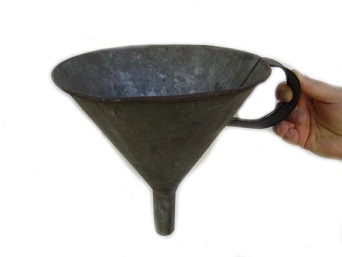Don’t Neglect the Top of Your Sales Funnel!
It’s not unusual for a company to complain they aren’t getting enough leads, but their only call-to-action (CTA) is a product demo or contact us form. If you’re devoting the majority of your time to the bottom of your sales funnel, chances are you’re neglecting the top of your sales funnel.
The top of the funnel is about awareness. This is where prospects find out about your product and services. They realize they have a need and they are looking for more information about how to solve their problem.
1. Create Buyer Personas
Identifying key buyer personas based on your ideal customer can help you determine earlier if a prospect has the potential to be a solid lead or not. It also helps you filter it from the top of the sales funnel into the appropriate marketing path.
For example, let’s look at Indecisive Ina. In the past, you’ve wasted countless hours providing similar prospects with every option your company offers, and she’s still slow at making a decision. She buys about 60% of the time, but she needs a lot of information, which translates to handholding by your sales reps.
If you identify a lead as an Indecisive Ina at the top of the funnel, you can send her to a campaign that will email her all the information about your product she could want, cutting down on the face-to-face time your reps need to spend with her.
Or, let’s say Marketing Mary, who is your ideal client in your focus industry, just downloaded a top of the funnel offer. You identified her as a decision maker, in your industry and you know she is probably at the beginning of the buying cycle, you can use lead scoring to ensure she is given the priority she deserves. Marketing Mary is scored higher and gets sent to a campaign that includes a quick call back from the sales rep to establish contact while she also will receive targeted information via email that is valuable to her throughout the buying process.
2. Have Appropriate Offers
Now, about that targeted information….
Prospects at the top of the funnel are interested in learning more about their problem and how to solve it. You can help them, and build trust, by providing them information to help them with their research. How? Don’t just give them information on your product, services or company. Instead, help them to figure out how to get through the process of solving their problem. For example:
- What questions should they ask of a potential vendor?
- How do they make the case internally for the product or service?
- What criteria should they use when evaluating vendors (a checklist is a great tool)?
- What are the difference between the products or services (e.g. if one vendor’s offering is SaaS and one is not, why should that matter?)
Notice that none of that is directly about your product or services. But, can you see the opportunity you have here? Give them the information with an honest, open effort to be helpful. Don’t bash your competition and go crazy about how wonderful you are. Just help them with information they can use and trust. Selling is about relationships. Build the relationship (and the trust) and you’re halfway there.
3. Segment Like Crazy
If I had to pick one area where I see even more knowledgeable companies struggling, it’s with segmentation. They may understand they need inbound and they may do email campaigns and offers with landing pages but they just have trouble with the concept of segmentation. Yet, this is a vital piece of the puzzle.
Segmentation is what makes sure you’re sending the right content to the right person at the right time. It keeps your lists healthy because you’re not bothering people with content they don’t want or need. It also is your money maker. If you have a list of those Marketing Mary’s you’ve identified and you know where they are in the buying process, you know what information you need to give them to help them through the buying process as well with the end result being a sale.
Segment from the beginning by identifying each prospect as a certain type of lead. Define your segmentation criteria, title industry, product interest are all valid criteria, but but you also include as many behaviors or actions as necessary to better segment each lead. For example, did the prospect convert on a contact us page or download a top of the funnel offer? These indicate the prospect is at different points in the buying process and may be segmented into different campaigns accordingly.
Here is another example: Let’s say a lead visits your website at least three times, downloads your whitepaper on increasing sales, and then signs up for your digital sales tips. Another lead calls your sales line and asks a lot of questions. These prospects may be separated into completely different buckets. The first likes to do everything online and would probably respond well to an email drip program, while the second one may want more face time with a sales rep.
4. Have Your Lead Score Sheet Ready
The more lead scoring you do at this stage, the fewer dead end leads you’ll have midway down the funnel. Make sure you’re taking into consideration any action that you deem moves the needle toward a sale. Make sure everyone in your sales organization is scoring leads according to your lead scoring strategy (Marketing Automation and CRM helps here).
5. Track Progress on Every Lead
Here is another area where I see a lot of struggle. When you’re doing inbound right — your buyer personas, buying process and content strategy are aligned and rock solid (meaning generating quality leads) — then you will get more prospects. That makes it even more important that you track the progress of the leads to ensure they are quickly followed up on or put in a nurturing campaign and don’t fall through the crack.
Inbound marketing is about generating leads, but your investment is worthless if all your new leads fall into a black hole and you close no sales from them.
Every single lead should be tracked from beginning to closing so that you have an accurate picture of your conversion rate. If you’re using a CRM, this shouldn’t be difficult, but take the time to set up the processes and reports, and do the analysis so you know what leads are coming in and where they are in the pipeline at all times.
6. Pay Attention to the Right Metrics
Not all metrics are created equal. If you pay attention to the right ones, they’ll help you hone your process. Some worth examining include:
-
Visitor to prospect conversion rate
-
Lead to opportunity conversion rate
-
Opportunity close ratio
-
Social shares
-
Customer referrals
-
Opportunities created
-
Web traffic
-
Clickthrough rates
-
Email open rates
With an eye on the top of your sales funnel, you’ll start to see better leads make it to the bottom, easier closes, and increased conversion.









